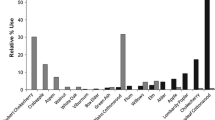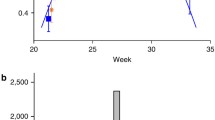Abstract
To evaluate the role of predation in the evolution of diet specialization and to determine the effectiveness of various larval defenses, we offered lepidopteran larvae to colonies of the tropical ant Paraponera clavata. We recorded behavioral and physical characteristics of prey items and used log-linear models to analyze their importance as deterrents to predation by P. clavata. The most important determinant of probability of prey rejection by P. clavata was a prey's diet breadth; specialists were rejected by the ants significantly more than generalists. Other less important, but significant, predictors of prey rejection included ontogeny, morphology and chemistry. Late instar caterpillars were rejected more frequently than early instars, hairy caterpillars were rejected more frequently than caterpillars with other morphologies, and one caterpillar species with an unpalatable extract was rejected more frequently than two species with palatable extracts.
Similar content being viewed by others
References
Agresti A (1990) Categorical data analysis. John Wiley and Sons, New York and Toronto
Atsatt PR (1981) Lycaenid butterflies and ants: selection for enemy-free space. Am Nat 118:639–654
Barbosa P (1988) Natural enemies and herbivore-plant interactions: influence of plant allelochemicals and host specificity. In: Barbosa P, Letourneau DK (eds) Novel aspects of insect-plant interactions. Wiley, New York, pp 201–229
Berenbaum MR (1990) Evolution of specialization in insect-Umbellifer associations. Annu Rev Entomol 35:319–343
Bernays EA (1988) Host specificity in phytophagous insects: selection pressure from generalist predators. Entomol Exp Appl 49:131–140
Bernays EA, Cornelius ML (1989) Generalist caterpillar prey are more palatable than specialists for the generalist predator Iridomyrmex humilis. Oecologia 79:427–430
Bernays EA, Graham M (1989) On the evolution of host specificity in phytophagous arthropods. Ecology 69:1153–1160
Bishop YMM, Fienberg SE, Holland PW (1975) Discrete multivariate analysis: Theory and practice. MIT, Cambridge
Blum MS, Severson RF, Arrendale RF, Whitman DW, Escoubas P, Adeyeye O, Jones CG (1990) A generalist herbivore in a specialist mode: metabolic, sequestrative, and defensive consequences. J Chem Ecol 16:223–244
Bowers MD (1990) Recycling plant natural products for insect defense. In: Evans, DL and JO Schmidt (eds) Insect defenses: adaptive mechanisms and strategies of prey and predators. University of New York Press, Albany, pp 353–387
Bowers MD (1992) The evolution of unpalatability and the cost of chemical defense in insects. In: Roitberg, BD and MB Isman (eds) Insect chemical ecology: an evolutionary approach. Chapman & Hall, New York, pp 216–244
Bowers MD, Larin Z (1989) Acquired chemical defense in the lycaenid butterfly, Eumaeus atala. J Chem Ecol 15:133–146
Breed MD, Bennet B (1985) Mass recruitment to nectar sources in Paraponera clavata: A field study. Insectes Sociaux 32:198–208
Brower LP (1958) Bird predation and foodplant specificity in closely related procryptic insects. Am Nat 92:183–187
Brower LP (1984) Chemical defense in butterflies. In: Vane-Wright RI, Ackery PR (eds) The biology of butterflies: symposium of the Royal Entomology Society number 11. Academic, New York, pp 109–134
Cates RG (1980) Feeding patterns of monophagous, oligophagous, and polyphagous insect herbivores: The effect of resource abundance and plant chemistry. Oecologia 46:22–31
Cott HB (1940) Adaptive colouration in animals. Oxford University Press, New York
DeVries PJ (1987) The butterflies of Costa Rica and their natural history. Princeton University Press, Princeton
Duffey SS (1980) Sequestration of plant natural products by insects. Annu Rev Entomol 25:447–477
Edmunds M (1974) Defence in Animals. Longman Group Limited, Essex
Edmunds M (1990) The evolution of cryptic coloration. In: Evans, DL and JO Schmidt (eds) Insect defenses: adaptive mechanisms and strategies of prey and predators. University of New York Press, Albany, pp 3–23
Ehrlich PR, Raven PH (1964) Butterflies and plants: a study in coevolution. Evolution 18:568–608
Eisner T (1970) Chemical defense against predation in arthropods. In: Sondheimer, E and JB Simeone (eds) Chemical ecology. Academic Press, New York, pp 157–217
Evans DL, Schmidt JO (eds) (1990) Insect defenses: adaptive mechanisms and strategies of prey and predators. University of New York Press, Albany
Feeny P (1976) Plant apparency and chemical defense. In: Wallace, JW and RL Mansell (eds) Biochemical interactions between plants and insects. Plenum, New York, pp 1–40
Futuyma DJ (1976) Food plant specialization and environmental predictability in Lepidoptera. Am Nat 110:285–292
Futuyma DJ, Moreno B (1988) The evolution of ecological specialization. Annu Rev Ecol Syst 19:207–33
Gross P, Price PW (1988) Plant influences on parasitism of two leafminers: a test of enemy-free space. Ecology 69:1506–1516
Guilford T (1986) How do warning colors work? Conspicuousness may reduce recognition errors in experienced predators. Anim Behav 34:286–288
Guilford T (1990) The evolution of aposematism. In: Evans DL, Schmidt JO (eds) Insect defenses: adaptive mechanisms and strategies of prey and predators. University of New York Press, Albany, pp 23–63
Hay ME, Pawlik JR, Duffy JE, Fenical W (1989) Seaweedherbivore-predator interactions: host-plant specialization reduces predation on small herbivores. Oecologia 81:418–427
Heinrich B (1979) Foraging strategies of caterpillars. Oecologia 42:325–337
Heinrich B, Collins SI (1983) Caterpillar leaf damage and the game of hide-and-seek with birds. Ecology 64:592–602
Holloway JD, Herbert PDN (1979) Ecological and taxonomic trends in macrolepidopteran host plant selection. Biol J Linn Soc 11:229–251
Jaenike J (1978) Resource predictability and niche breadth in the Drosophila quinaria species group. Evolution 32:676–678
Janzen DH (ed) (1983) Costa Rican natural history. University of Chicago Press, Chicago
Janzen DH, Carroll CR (1983) Paraponera clavata. In: Janzen DH (ed) Costa Rican natural history. University of Chicago Press, Chicago, pp 752–753
Jones CG, Whitman DW, Compton SJ, Silk PJ, Blum BS (1989) Reduction in diet breadth results in sequestration of plant chemicals and increased efficacy of chemical defense in a generalist grasshopper. J Chem Ecol 15:1811–1822
Jones FM (1932) Insect colouration and the relative acceptability of insects to birds. Trans Roy Entomol Soc Lond 80:345–385
Jones FM (1934) Further experiments on colouration and relative acceptability of insects to birds. Trans Roy Entomol Soc Lond 82:443–453
Kareiva P, Sahakian R (1990) Tritrophic effects of a simple architectural mutation in pea plants. Nature 345:433–434
Kawamoto F, Kumada N (1984) Biology and venoms of Lepidoptera. In: Tu, AT (ed) Handbook of natural toxins. Marcel Dekker, New York, pp 270–351
Levins R, MacArthur RH (1969) An hypothesis to explain the incidence of monophagy. Ecology 50:910–911
Marquis RJ, Braker HE (1991) Plant-herbivore interactions at La Selva: diversity, specificity and impact. In: McDale LM, Bawa KS, Hartshorn GS, Hespenheide HE (eds) La Selva: Ecology and natural history of a neotropical rain forest. University of Chicago, Chicago
Moran NA (1988) The evolution of host-plant alternation in aphids: evidence for specialization as a dead end. Am Nat 132:681–706
Price PW (1991) Patterns in Communities Along Latitudinal Gradients. In: Price PW, Lewinsohn TM, Fernandes GW, Benson WW (eds) Plant-animal interactions: evolutionary ecology in tropical and temperate regions. John Wiley & Sons, New York, pp 51–70
Price PW (1983) Hypotheses on organization and evolution in herbivorous insect communities. In: Denno RF, McClure MS (eds) Variable plants and herbivores in natural and managed systems. Academic Press, New York and London, pp 559–598
Price PW, Bouton CE, Gross P, McPheron BA, Thompson JN, Weis AE (1980) Interactions among three trophic levels: influence of plants on interactions between insect herbivores and natural enemies. Annu Rev Ecol Syst 11:41–65
Pyke GH (1984) Optimal foraging theory: a critical review. Annu Rev Ecol Syst 15:523–575
Rhoades D, Cates RG (1976) Toward a general theory of plant antiherbivore chemistry. In: Wallace J, Mansell R (eds) Biochemical interactions between plants and insects. Recent advances in phytochemistry 10. Plenum Press, New York, London, pp 168–213
Ricklefs RE, O'Rourke K (1975) Aspect diversity in moths: a temperate-tropical comparison. Evolution 29:313–324
SAS (1990) SAS User's Guide: Statistics. SAS Institute, Cary, NC
Sheehan W (1991) Host range patterns of hymenopteran parasitoids of exophytic lepidopteran folivores. In: Bernays EA (ed) Insect-plant interactions, volume III. CRC Press, Boca Raton, pp 209–248
Strong DR (1988) Insect host range. Ecology 69:885
Tabachnick BG, Fidell LS (1989) Using multivariate statistics. Harper & Row, New York
Weiss AE, Berenbaum MR (1989) Herbivorous insects and green plants. In: Abrahamson WG (ed) Plant-animal interactions. McGraw Hill, New York, pp 123–157
Wilson EO (1971) The insect societies. Harvard University. Cambridge MA
Young AM (1977) Notes on the foraging of the giant tropical ant Paraponera clavata (Formicidae: Ponerinae) on two plants in tropical wet forest. J Georgia Entomol Soc 12:41–51
Young AM, Hermann HR (1980) Notes on the foraging of the giant tropical ant Paraponera clavata. J Kans Entomol Soc 53:32–55
Author information
Authors and Affiliations
Rights and permissions
About this article
Cite this article
Dyer, L.A., Floyd, T. Determinants of predation on phytophagous insects: the importance of diet breadth. Oecologia 96, 575–582 (1993). https://doi.org/10.1007/BF00320516
Received:
Accepted:
Issue Date:
DOI: https://doi.org/10.1007/BF00320516




